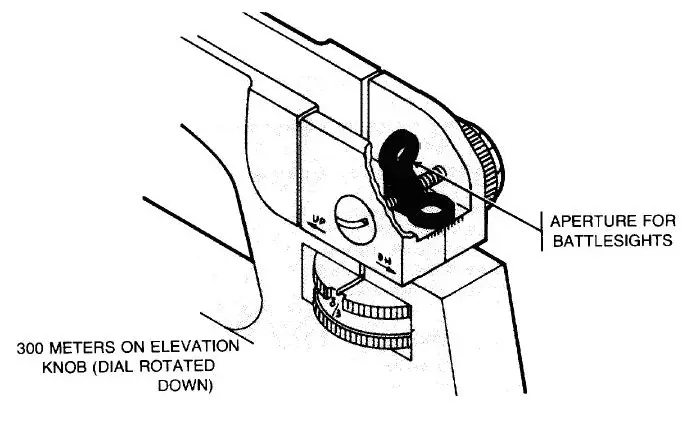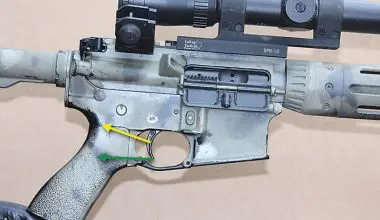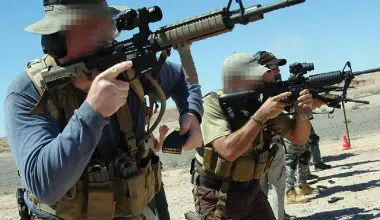For the last 20 years, the Special Operations Peculiar Modification (SOPMOD) program has been equipping Special Operations Forces (SOF) with optics and accessories that allow them to shoot faster, farther, and more accurately than the enemy. In the May issue of S.W.A.T. (Block I and The Early Years in Iraq), I covered the time when Block I first hit the teams and my experience with those items during my combat tours in Iraq.
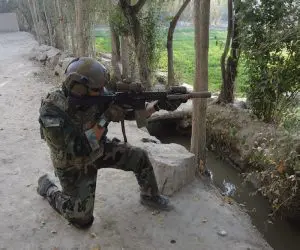
Let’s move on to the development and implementation of SOPMOD Block II, including my experience with Block II items while deployed to Afghanistan.
While SOPMOD Block I optics got the job done, one thing that was realized early on in both Iraq and Afghanistan was that the Aimpoint, EOTech, and Trijicon ACOG offered only enhanced capability for a specific range in shooting.
Yes, the Aimpoint and EOTech can work past 300 meters, improving a shooter’s chances of getting long-distance hits, but let’s face it, trying to hit a moving human target out past 300 meters with a red dot can be very challenging. And yes, a Trijicon ACOG can be used for close-range shooting, but at a fixed four power, it’s not ideal, as operators were finding out as they were getting into real firefights. This held true even if the mission was merely a single target building, where they’d expect just room-to-room CQB as they cleared the building. In reality, they were having to fight their way to the target, on target, and as they ex-filled the target.
That meant having to engage threats anywhere from room distance out past 500 meters at any time. So regardless of which optic was on the carbine—Aimpoint, EOTech or Trijicon ACOG—for 50% of the mission, it was not the proper choice for the range the enemy was at. We needed something that offered dual capability on the M4A1, enhancing one’s ability to hit both near and far targets at any time. The first attempts to address this dual capability came about circa 2005. That is when I saw the first piggy-backmounted mini-red dot on an ACOG, the SU-237.
Also near this time, red dot magnifiers were making their way to some teams. While these items were both workable, they were still not the ideal answer. The mini Docter red dot mounted on top of the ACOG usually requires the operator to lift his head up slightly off the stock to get a good sight picture—not the most stable or fastest method of shooting. At almost five inches height above bore, that is a lot of holdoff the shooter has to account for, depending on the range of the target.
The issue with red dot magnifiers is that, while they do give the shooter three to four power magnification, they also amplify the size of the red dot.
So while you can see a long-range target better, with the old M68, the four MOA dot with magnification now appears as a 12 MOA dot. Placed on a 400-meter target, it will appear as a 48-inch circle. At twice the width of a normal person, it’s very hard to determine where your hold (dot) is on the target to hit at whatever range the enemy is at.
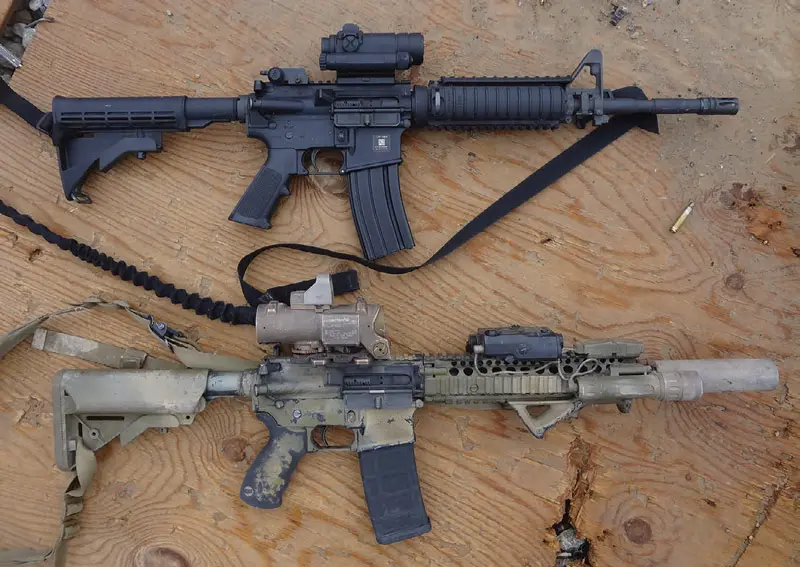
Table of Contents
DUAL CAPABILITY, PROBLEM SOLVED: SOPMOD BLOCK II
If I had to choose one SOPMOD item that has made the biggest impact with Special Forces soldiers, it would be the ELCAN SpecterDR (SU-230 Articulated Telescope). In fact, since its adoption with SOPMOD Block II in late 2007, it’s a safe bet that more insurgents in Afghanistan have been killed by SOF soldiers using SU-230s than any other optic mounted on M4s and MK18s.

Finally, with the 1-4X variable power ELCAN, we had one optic that with a simple flip of a lever was well suited to both CQB and long-range shooting. Additionally, for those who were comfortable with piggy-backed mini red dots, it also came with the same Docter red dot on top.
PERFORMANCE
To this day, the ELCAN with its 5.56 BDC (bullet drop compensator) reticle still has one of the best fields of view of any 1-4X scope I have ever played with. And despite early skepticism about its external windage and elevation adjustment mechanism, using an ELCAN-equipped M4A1 in training to get hits out to 650 meters is easy. In combat, the ELCAN has proven to be a tough and reliable combat optic.
I used one mounted on both an M4A1 and MK18 upper for two tours in Afghanistan. Even on the shorty MK18, getting hits around the 500-meter mark is doable in combat using the ELCAN with Mk262 77-grain match-grade ammunition.
Probably the biggest reason most operators (myself included) run an ELCAN, even on the MK18, is the enhanced ability it affords the shooter to scan for threats and spot hits for bigger weapon systems that are much better suited for hitting targets at extended ranges.
In the mountains and hills of Afghanistan, with just the ELCAN on my carbine I was successful spotting and talking onto targets as distant as 700 meters away M2 .50 calibers, 60mm mortars, and M134 miniguns at least half a dozen times.
It is only just in the last two years (my third and last Afghan tour) that I thought the 1-4X ELCAN was getting a little out of date. In the fall of 2015, I switched out my trusty ELCAN for a Trijicon 1-6 variable power VCOG.
The reason was not that I was trying to extend the range of the M4A1 and MK18 any farther. Let’s face it, 5.56 is only good for so far. It’s just that with the extra magnification, it gave me the best possible chance of getting hits on targets at 300 to 500 meters—well within the performance range of the Mk262 round from a 14.5-inch barreled M4A1. There are, in fact, 1-6X power ELCANs on SF teams. But since they come with a BDC only for 7.62mm, they are primarily used on the FN SCAR-H (MK17).
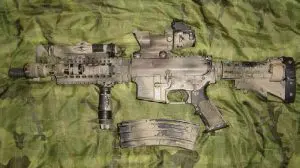
MORE RAIL SPACE
Another issue SOPMOD Block II did a great job addressing was the lack of rail space on the M4A1 and the first MK18 upper (with front sight post). When SOPMOD debuted the carbine-length Knight’s Armament RAS (or RIS I) forearm, it was actually seen as an outstanding accessory by most Assaulters.
But adding the PEQ-2 laser and a white light did not leave much room for your support hand. It was not an issue at first because in the late 1990s, the V-grip (palm facing up on the bottom of the rail) was still the primary gripping technique.
And as much as I hate to admit it, also just as popular was holding onto the vertical grip with your entire support hand. Yes, I know that’s not the most stable technique, but luckily we all evolved, and by 2006 the wrist-over or C-clamp grip (palm on side of rail with thumb on top) was in widespread use. The C-clamp grip was in use prior to being made famous by the very popular Magpul Dynamics videos.
I think better gripping techniques that required more forearm extension (more rail space), and the rise of slim, full-rifle-length rails doing well in 3-gun matches influenced the demand for better rail systems for the military carbine.
In 2007, I heard we were getting the Daniel Defense RIS II FSP (front sight post cut-out version). Like many SOPMOD items, it took an extremely long time to outfit all teams with it. How long? I was not issued one until 2014 (my second tour in Afghanistan), and the newest RIS II, with no front sight cut-out, not until my last combat tour in the fall of 2015!
Another great item to come out of Block II was the ATPIAL (LA-5) IR and visible aiming laser, replacing both the CVL AN/PEQ-5 visible red laser and AN/PEQ-2 IR laser. Two benefits of the LA-5 are that it projects a stronger IR beam and flood laser, and that using the co-aligned visible red laser, you can zero it in daytime (if it’s not too sunny).
Despite the popularity of visible red lasers with “Special Ops” in Hollywood movies, in real life no one uses visible lasers in combat.
The only thing I don’t like about the LA-5 is that it attaches to the rail via a screw, as opposed to every other item on the planet, which use a locking throw lever. If you do not regularly check it, it can come loose (losing your zero), or worse, fall off completely. Hence common practice is to zip-tie it down to the rail. As far as zeroing the LA-5, I have found dialing it onto the dot of my primary optic while aiming at something 100 to 200 meters away works just as well zeroing it as shooting groups does.

WHERE BLOCK II FALLS SHORT: LIGHTS
In late 2006, I saw the first weaponlight with a LED bulb: the SureFire X200 pistol light. So LED technology did exist during SOPMOD Block II’s roll out, but the light chosen for Block II, the SU-233 Gun Light (MX3 by Insight Technologies), had a halogen (incandescent) bulb.

Like the previous Block I weaponlight, the VLI, it was too dim (producing at best 125 lumens), and the bulbs did not stand up well to the shock and recoil of shooting. In one year over the course of 8,000 rounds, I went through two bulbs.
Another issue with a halogen/incandescent bulb is that it does not produce a true white light. It is more of a yellowish light and, when it starts to dim, it gets worse and becomes more of what is referred to as “dirty light,” where it’s hard to see objects clearly. This also applies to the edges of the cone of light, where it is again hard to distinguish what you are seeing.
In CQB, dirty-light areas and shadows produced by weaponlights tend to slow the Assaulter’s pace because he cannot go past something until he knows it’s clear. And that’s not to mention the possibility of getting shot by someone in the shadows.
The true white light produced by LED bulbs is not only a clearer form of light, but the beam produced by LED bulbs also has a more solid edge, making it easier to distinguish where you can see clearly and where you can’t.
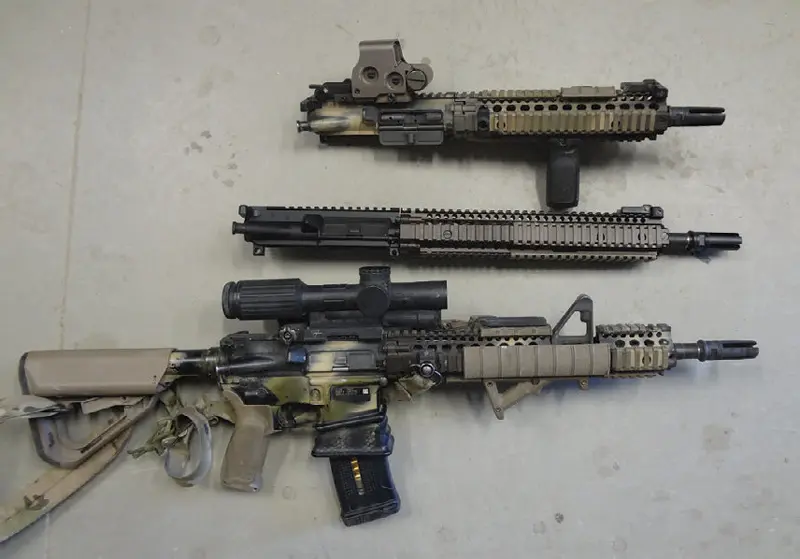
Unfortunately, the MX3 was not replaced until late 2010, and that was with another Insight Technology light, the WMX200. It has a built-in hinge designed to fold down, allowing its position on the forearm to be changed. The problem is it does not stay tight, leading to the light flopping around on the rail. (At least it utilizes a LED bulb.) I never used either light in combat. In 2005, I purchased a Blackhawk Gladius light. It has proven indestructible, surviving one tour in Iraq and three tours in Afghanistan—with its original bulb!

CQB SIGHTS
By now everyone is aware of the zero shift/temperature issues of EOTechs. As I stated in Part I, I’m not a fan of EOTechs, as I find the EOTech circle/ dot reticle too busy for my eyes. I prefer a single dot. Are guys still using the latest SOPMOD SU-231A, the EOTech EXPS3? Yes, they are. The reason? While it may suffer from zero shift from temperature changes, there is not much temperature shift going on during a three- to six-month combat tour in the Middle East.
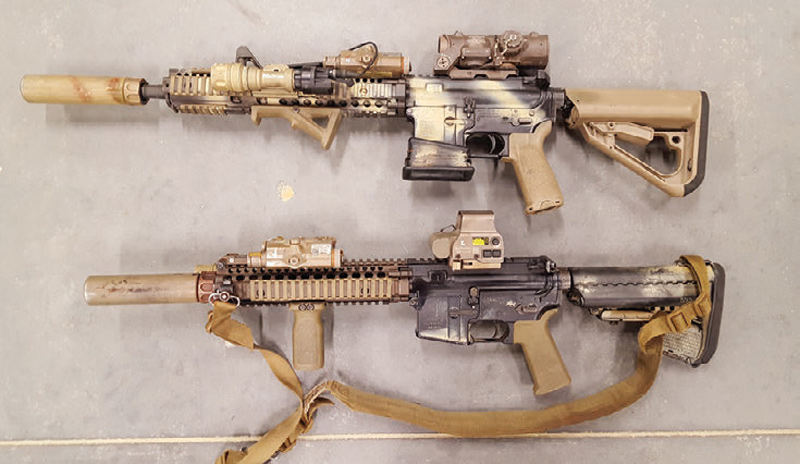
Have I seen issues with EOTechs? Yes, I have seen some with very poor parallax, where the reticle appears to fade unless you are perfectly aligned behind it. But I have seen an EOTech retain its zero even with a cracked lens from being banged up in combat. With soldiers, though, I think in terms of reliability it all boils down to a shooter’s personal confidence with an item. If it works well for you, then by all means drive on with it.

As USSOCOM now searches for a replacement for the EOTech (possibly the Aimpoint T1), I hate to point out that back in 2010, most SF teams were also issued Aimpoint CompM4s. But for some unknown reason, we were forced to turn them all in! As I write this, EOTechs are still in use by a lot of SF teams.
SUPPRESSOR
The last Block II item worth covering is the SureFire SOCOM suppressor, a total game changer. While the previous SOPMOD Knight’s Armament suppressor worked, I was never a fan. The extra gas blowback and increased muzzle weight were too much of a tradeoff for its suppression capability. In addition, it had a relatively low round count capability and had to be run “wet” (fill with water, then shake the water out and tape the muzzle closed to keep moisture on the baffles) for optimal performance.
I say the SureFire SOCOM suppressor is a game changer because, between sound suppression and virtually no muzzle flash even with the short MK18 upper, it’s very difficult for the enemy to pinpoint your position in order to return accurate fire. And with the ludicrously high round count it can handle, you can basically put it on your carbine and forget about it.
Still a little on the heavy side, but it especially complements the MK18 very well, doing a great job of taming the blast and allowing for very fast follow- up shots.
Critics will point out that some quieter and lighter suppressors exist. True, but military operators don’t need it to be super quiet, just quiet enough to be able to shoot the carbine without ear pro. I used one for two tours in Afghanistan, first mounted on an MK18, then later I switched it onto an M4A1 for longer range.
I’ll admit it made the rifle heavy to carry on a 14.5 upper. But on more than one occasion, I was able to put it to great use, returning fire from cover at PKMs shooting at us from 500+ meters away with good effect and, more importantly, with the enemy having no idea where I was.
THE FUTURE
What should the next wave of SOPMOD items be? For optics, I’d like to see a 1-6X, 5.56 BDC, ELCAN or equivalent, the same size as the current SU- 230, also perhaps a compact red dot sight with built-in thermal or IR laser capability.
For the M4A1/MK18, a slicker, narrower forearm. The Magpul M-LOK gets my vote. On the current quad rail design of the RIS II, the circumference of the rail is rather large. A narrower one would better facilitate the various wrist-over or C-clamp style grips most Assaulters use.
Whatever does come next with SOPMOD, based on the performance over the last 20 years it has been in implementation, I feel confident the program will continue to provide our nation’s Special Operations Forces with the best small arms accessories, allowing them to keep winning against the enemy during small-arms engagements.


